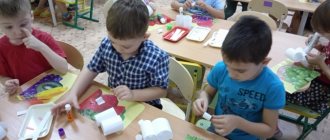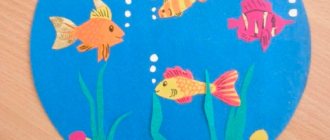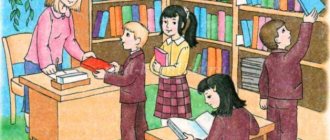Curiosity is the natural state of any child. “Mom, why is it raining?” Why is the sky blue? Why is the candle burning? And so on endlessly. Is this a familiar story? Naturally, the child wants to know everything. We offer you interesting experiments with air that will satisfy children's curiosity and explain the laws of nature at a level accessible to kids.
1. We breathe air
Tell your child that we breathe air. He is around us, but invisible. Suggest an experiment: fill a glass with water, take a cocktail straw and blow into it. There will be air bubbles in the glass.
2. Parachute
Make a small parachute with your child. Take a handkerchief and attach threads of the same length to each corner of the handkerchief using a needle. Attach all ends to the toy. Tell your child why the parachute descends smoothly: the air under the canopy expands and supports it.
3. Weigh the air
Everything has its own weight, air too. Invite your child to weigh it. Take a ruler, find its center and tie a string to it. Inflate balloons of the same size and tie with threads of the same length. Now we hang the balls along the edges of our “scales”. The scales are balanced. We pierce one balloon - the inflated balloon goes down - it is heavier.
4. Does the air have a smell?
Let's check if the air has a smell. Invite your baby to smell the air - you can’t hear the smell. Now spray the room with eau de toilette or orange. Tell your child that air can transmit odors.
5. Cold or hot?
Teach your child that air can heat up and cool down. Take a plastic bottle and place it open in the refrigerator for a while. Take it out and put a balloon on the neck. Now put the bottle in a plate with hot water. What's happening? The balloon began to inflate on its own. Why? Because air expands when heated. And if you put the bottle in the refrigerator again, the ball will deflate.
6. Why doesn't it burst?
Surely your child knows what will happen if the ball is punctured. It will burst. Offer your little one an experiment. Place a piece of tape on both sides of the ball. Pierce the tape with a needle. What's happening? The ball doesn't burst.
7. Inflate a balloon in a bottle
For this experiment you will need two plastic bottles. In one of them we make a hole slightly higher than the bottom. We put a balloon in each bottle, pull the edges over the neck and try to inflate the balloon. Who will succeed - the dad or the baby?
8. Flight into space
We make a rocket - we roll the paper into a tube, glue one end and attach three triangular supports. Place a rocket on any support, insert the tube with one end into the rocket and the other into an empty plastic bottle. Seal the neck tightly with tape. Install the rocket. Place the bottle on the ground and position the rocket at the length of the elongated tube.
- On your marks! Attention! March!
Have your child run and step on the bottle as hard as he can. The rocket must fly into space.
9. Will he fall or not?
Take the funnel and turn it wide side down. Place a ping pong ball in it and hold it with your finger. Now blow into the narrow end of the funnel and stop supporting the ball. It will not fall, but will remain in the funnel.
This is explained by the fact that the air pressure under the ball is much greater than above it. And the harder you blow, the less air puts pressure on the ball, and the greater the lifting force. Give it a try.
Personal website of Valentina Nikolaevna Bulygina
Dear parents!
You have a unique opportunity to participate in the creation of our mini-museum.
Think about how and where people use air and its properties? With your children, look for objects in your environment that use air. All of them can become exhibits of our mini-museum. We will be glad to accept any help in creating the mini-museum “Invisible Air”!
In addition, we offer the following game exercises and mini-experiments that help determine the properties of air. You can use them as a fun and, most importantly, useful way to spend time with your children at home. This will help consolidate the knowledge acquired in kindergarten and increase interest in the mini-museum:
“Come on, blow it”
Using a cocktail straw, blow a paper ball off the table or from your palm. You can offer to play the game “Football”. All with the same paper balls, just set up a goal.
We will take air into our mouths and begin to blow on the ball. The ball seems to come to life, kicking along the table.
"Looking for the invisible man"
Tell your child that we are surrounded by air. It is everywhere, but we don't see it. How can you be sure that it really exists? Let's hang strips of paper or ribbon in the middle of the room (for example, on a chandelier). They will begin to move in a draft. So we saw you, invisible air!
"The Invisible Man's Trap"
Is it possible to catch this elusive trickster? It turns out yes! Let's make a trap from an ordinary plastic bag or rubber glove (it will be funnier this way). First, open the bag (or glove) wide. The air, suspecting nothing, will climb inside...
This is where we quickly twist the edges of the bag and tie it tightly with an elastic band. Look how the bag is swollen! It is immediately clear that there is something there. Gotcha, invisible! Well, shall we let him go?
Then we untie the package. He immediately deflated. But we now know that our invisible man is still here.
"Storm in a Teacup"
Invite your child to inhale through his nose and exhale into a tube, the end of which is in a glass half filled with water.
"Rescue Bubbles"
Pour plain water into one glass and mineral water with gas into the other. Ask your child to throw them there, and throw pieces of plasticine the size of grains of rice there.
Watch what happens: in plain water the plasticine will sink to the bottom, but in mineral water it will first sink and then float to the surface. Why did it happen? Because air bubbles raise the plasticine to the surface. When the gas is exhausted, the plasticine will sink.
"Ships"
Invite your child to blow on paper boats floating in a basin of water, sometimes smoothly, for a long time, sometimes quickly, and watch the movement of the boats.
"Butterfly (bird)"
Attach a paper butterfly (bird) to a string. Invite the child to blow smoothly with his mouth, without puffing out his cheeks, and the butterfly will fly.
"Snowflake"
Invite the child to blow cotton wool or tissue paper from his palm with a light, long mouth exhalation.
"The Wind and the Leaves"
Cut out several strips (7-10) from thin paper and attach them to a stick, invite the child to blow with the wind and the “leaves” will sway.
Do not forget that the child should not take convulsive, sharp breaths with raised shoulders and tension. The inhalation should also be calm.
07/05/2021 at 22:11. Categories: Consultations for parents.
Experiment “Volume of warm air”
Our entire space is filled with air. Has your child ever thought that he could feel his presence at any moment? You can incredibly captivate your young explorer if you tell him about the “miracles” that air can create. For example, it can shrink and expand. Its behavior changes depending on temperature. Is it possible? Try this fun science experiment for kids to see what happens to a balloon when you heat the air inside it. Before the experiment, ask your child what air is? Ask him to describe the air in simple words. Do we feel it? Can we see air? What is it like? Can he penetrate everywhere? Talk to your child about air, and his answers will pleasantly surprise you. What you will need for the experiment:
- Empty glass or plastic bottle.
- Balloon.
- A saucepan of hot water (but not boiling water).
What you will need to do: 1. Take an empty glass bottle. At this moment you can ask the child if it is really empty and if there is air in it? Then take a balloon and pull it tightly over the edge of the bottle neck. Explain to your child that for the purity of the experiment, everything must be sealed so that the volume of air in the bottle remains unchanged. 2. Wait a moment to see if something happens on its own if you don't act on the bottle in any way. When the child is convinced that nothing is happening, proceed to the next step. 3. Place the bottle with the ball stretched on it in a pan of hot water. Let the child carefully monitor what happens to the ball. 4. After a few minutes, ask the child to describe the result of the experiment. What happened to the ball? Ask your surprised child why he thinks the balloon started to inflate. Where did the air come from? 5. You can continue the experiment by placing the bottle with the ball in the refrigerator, after which the child will be able to visually observe the reverse process and be convinced of the knowledge gained.
What's happening? When the air inside the bottle heats up, it begins to expand. Since the kinetic energy of air molecules increases with increasing temperature, they begin to move faster and move away from each other. The distance between the molecules increases and this causes the balloon to stretch. At the same time, the amount of air inside the ball and bottle remains the same as it was, it simply expands when heated and takes up more volume. Consequently, warm air takes up more space than the same amount of cold air. Warm air weighs less than cold air occupying the same space because it contains fewer molecules. This principle can be seen in action when flying in a hot air balloon.








